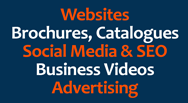Powerful Print Ads . . . Yours to Create!

THESE STEP-BY-STEP guidelines will help you produce powerful a print ad that sells – in your local paper, magazines or Yellow Pages.
1. Have a Plan
I know I’ve said it a thousand times before but without a plan you risk spending thousands of dollars on a useless, ineffective and costly campaign that fails to bring you any new business.
I get a creative plan for every job I take on. That way, I make sure I write an ad that’s targeted to the right people, written in the right tone of voice and published in the right media.
Here are the main points a creative plan should cover:
- Objectives: What is the ad trying to do? Sell more products, generate awareness or launch a new product or service? First, determine the ad’s objectives. Then quantify them. For example, I want to attract potential buyers who don’t have an immediate need for my product, or I want to achieve 50% more awareness among my target group.
- Target Audience: Who buys the product? For years advertising agencies have based their client’s advertising campaigns on demographics because certain approaches appeal to different groups of people. I won’t start trying to explain the ins and outs of demographic profiling but before you start your campaign you should consider whether your target prospect is a man or a woman, young, middle aged or old, rich, poor or average. Because determining this will drive every aspect of your ad.
- Proposition: What is the main benefit you want to convey? If you’re selling insurance the main benefit could be peace of mind and security. If you’re selling a car the main benefit could be sporty yet economical. It’s important to find the right benefit for your target market. Value for money may be a great benefit for someone on a tight budget but if your target market is more concerned with quality it will have a negative effect.
- Supporting Evidence: Can you justify your proposition? Do you have facts, figures and research to back up your claim? You have to give people a reason to believe in your product. You can’t just say ‘Our socks will keep your feet warmer’, you have to prove it. Perhaps your socks are hand- knitted with wool shorn from sheep that roam free on the Scottish highlands. If so, use facts and figures, market research, testimonials or endorsements from people who are experts in their field to prove your claim.
- Other benefits: Apart from the main proposition, what are the other benefits the ad should mention? Here’s where it can get a little tricky. But there’s always more than one benefit. There’s always more than one. Try making a list of benefits and ranking them in order of importance.
- Tone of Voice: If the ad were a person, would it be young or old, efficient, whimsical, happy-go-lucky, high-powered or homely? You must write the ad in a language that appeals to your target audience.
- Media: Where will you place the ad? Your choice dictates the style of the ad because each media is read by a different demographic group of people. An ad designed for a science magazine is going to look different from one placed in a parenting magazine.
2. Create the Concept
Once you have a clear idea of the ad’s focus it’s time to move on to the next important step: the concept. A concept is essentially an outline or rough idea of the ad that helps you get your ideas down on paper. I like to draft about 15 concepts for each ad I write because each one triggers an afterthought that may just produce the concept I’m looking for.
Once you’ve decided on a concept that works, you need to ‘work it up.” In other words begin working on the three main components of the ad: the headline, the visual and the body copy.
3. Write the Headline
The headline does two very important jobs. First, it attracts the reader’s attention. And second, it persuades him or her to buy. You can use a headline to get your reader’s attention in several ways:
- Make it big and bold. And make the words jump off the page yet be simple enough for a passing reader to understand.
- Make the reader stop and think.
- Offer an important benefit
- Promise a reward for reading the copy
- Make it newsworthy
There’s a tendency when writing a headline to try and make it amusing or clever. Or place it in smallish print low down on the page. This is particularly true of some corporate advertising you see in magazines and newspapers today. Don’t be fooled by this ‘corporate chic’ approach. A straightforward informational headline works better. There is absolutely nothing wrong with ‘20% off all bedding now’.
4. Write the Body Copy
There’s a chance that if your headline and visual have attracted the reader he or she may be compelled to read body copy. Consider this a bonus because if people read the body copy, you’ve got a better chance of selling them your product or service. To encourage people to read the copy, try breaking it up with small illustrations and sub heads. Or lay it out in a visually interesting way.
Writing the copy itself presents its own challenges, especially if you’re not accustomed to writing in a friendly, normal tone of voice that shows your natural enthusiasm for the product. Try to imagine someone has asked you about your product. How would you talk to him or her? You’d probably speak with a quiet conviction, telling him about the product’s benefits and demonstrating how it works.
Whatever you do don’t try and explain every little detail about your product. Keep it simple and benefit oriented.
If you want to talk over these Get More Customers ideas, or other effective tactics that I have, give me a call 0414 955 743 – advice is totally free of charge.
Cheers,

John



